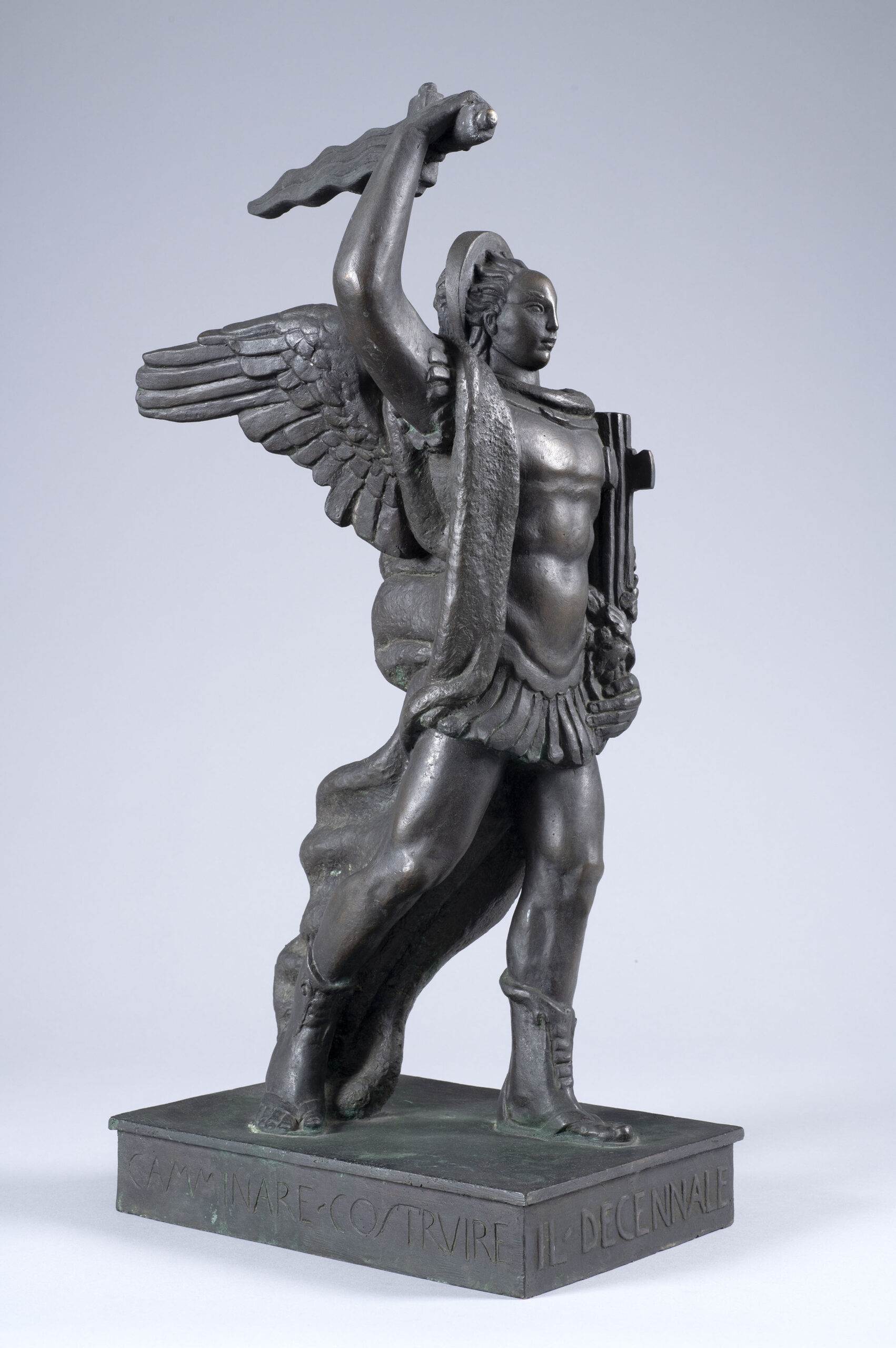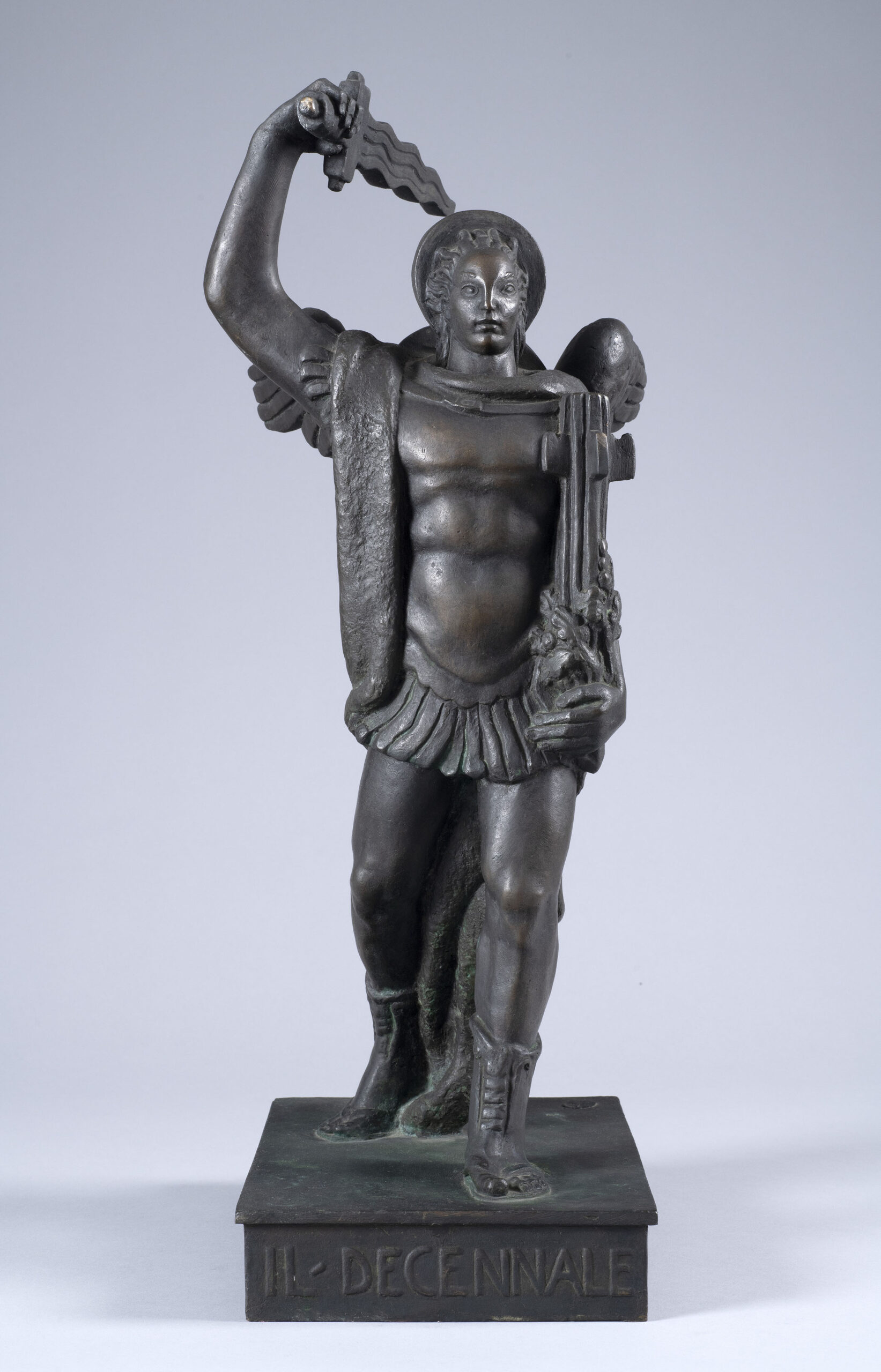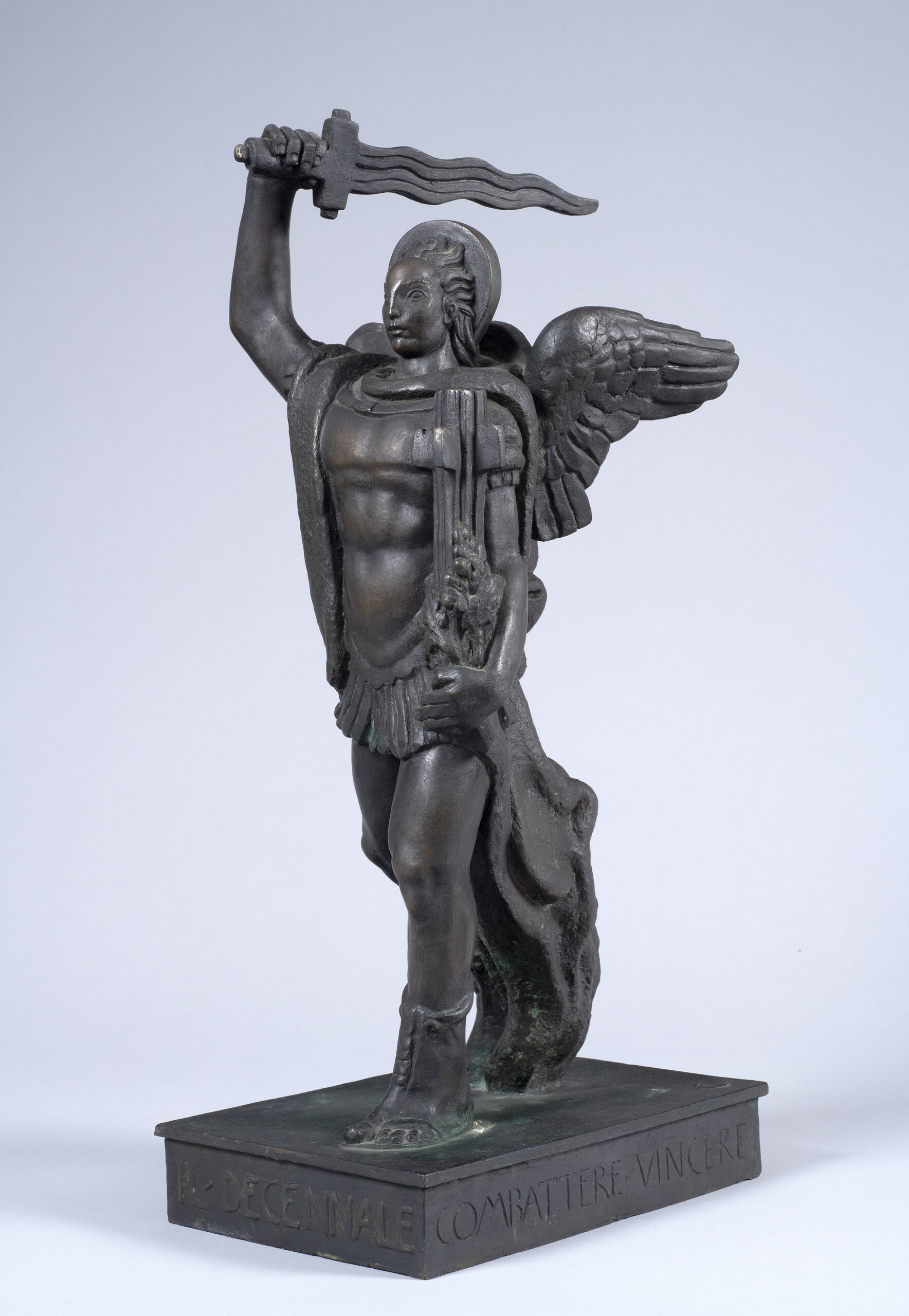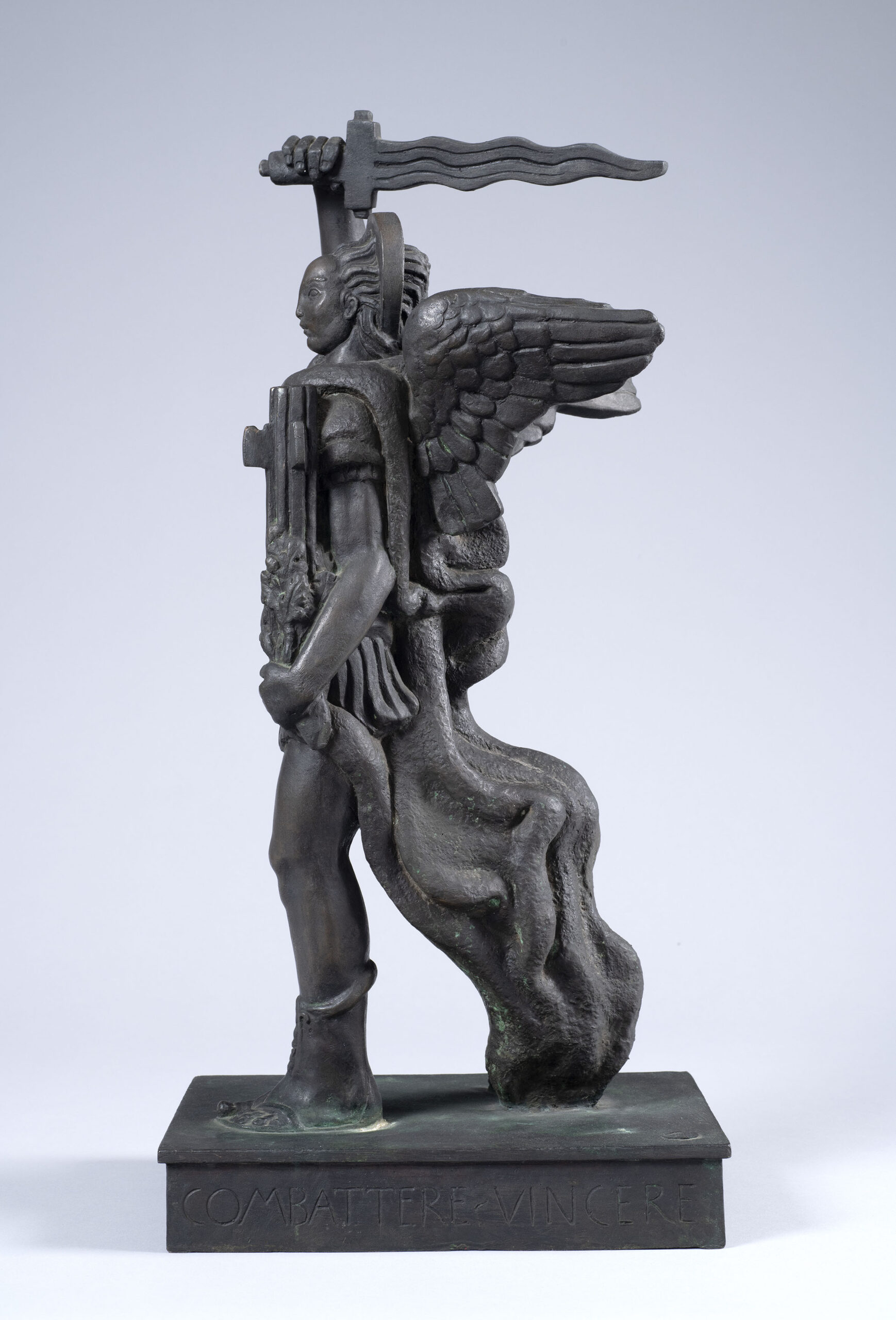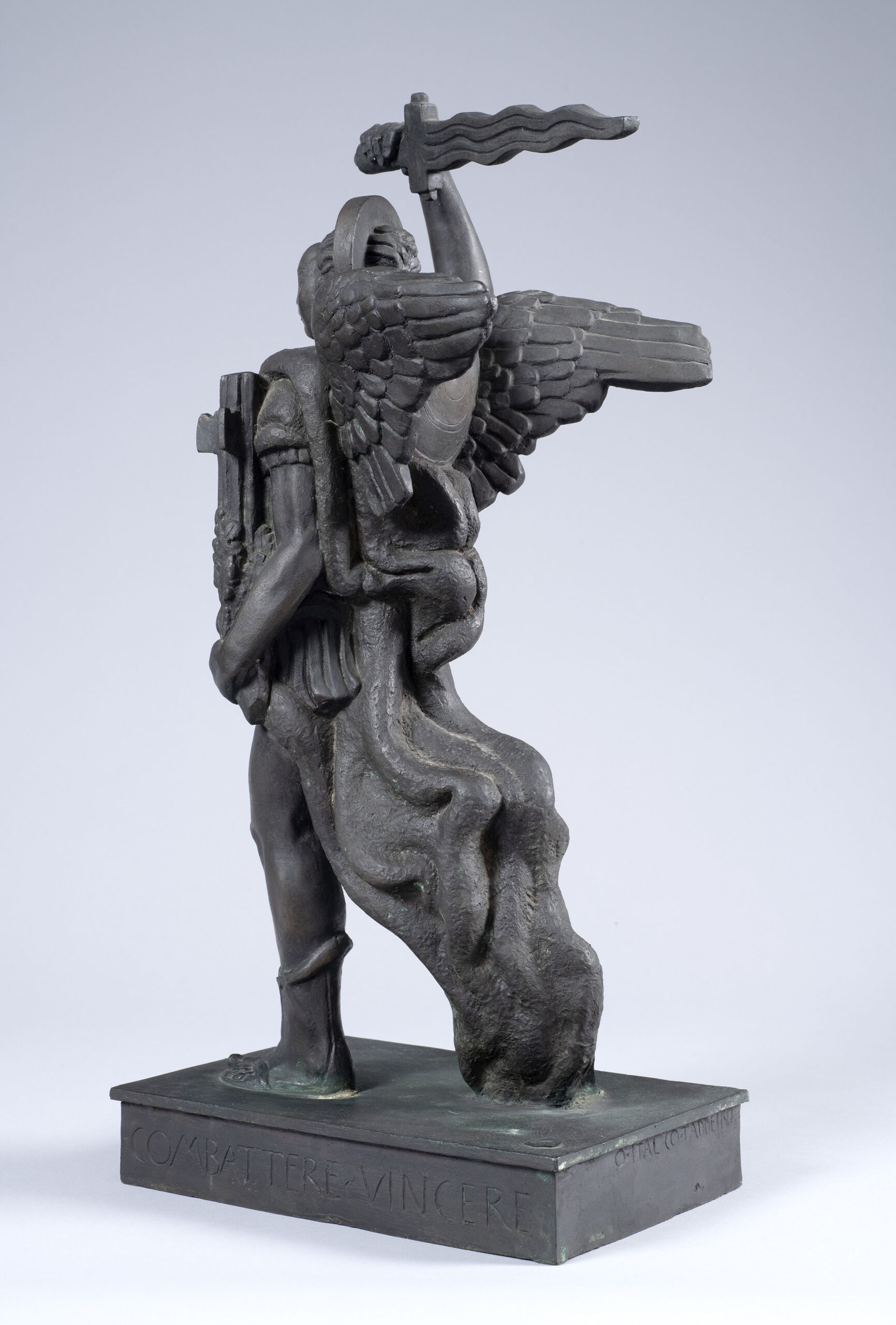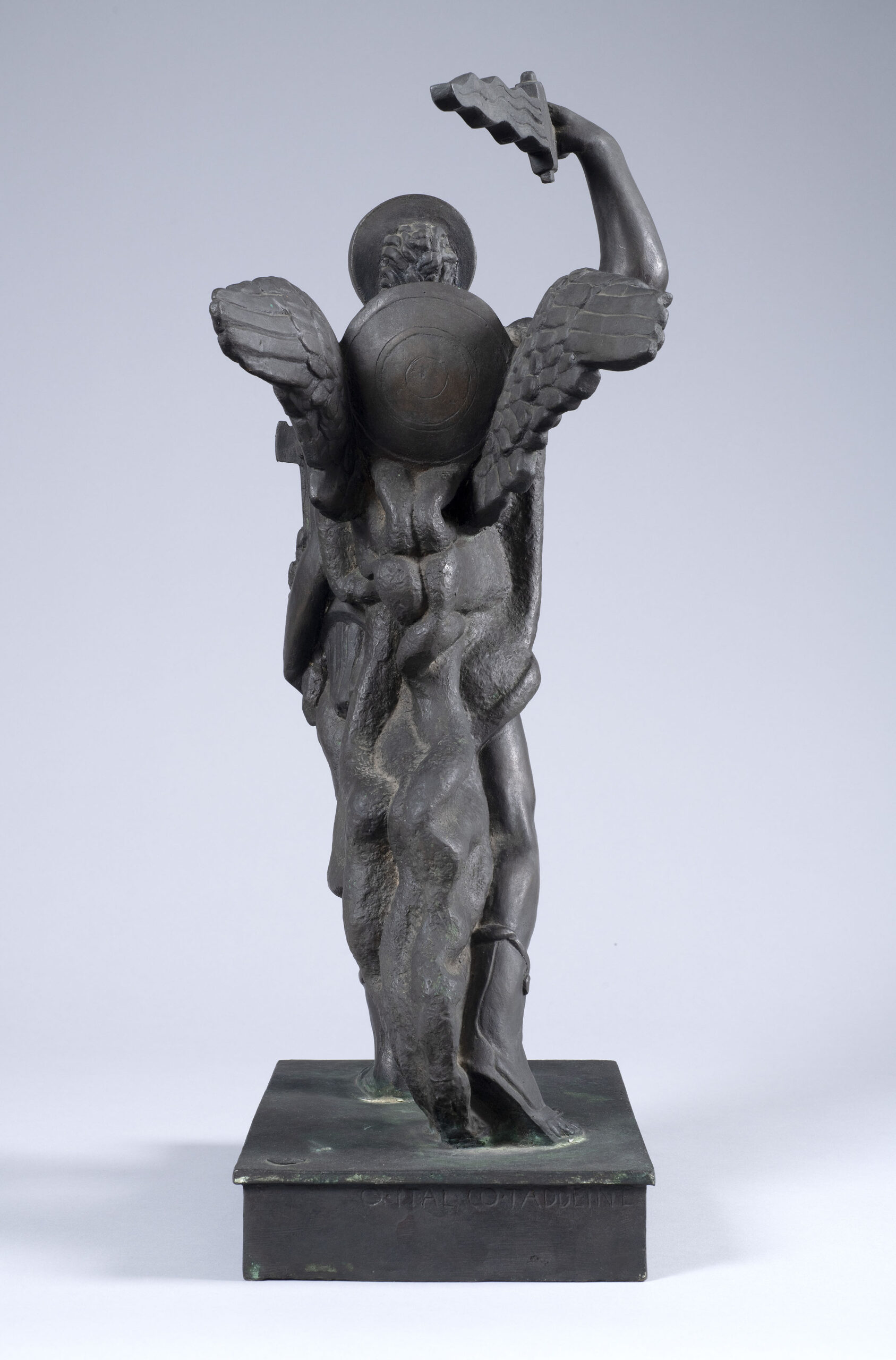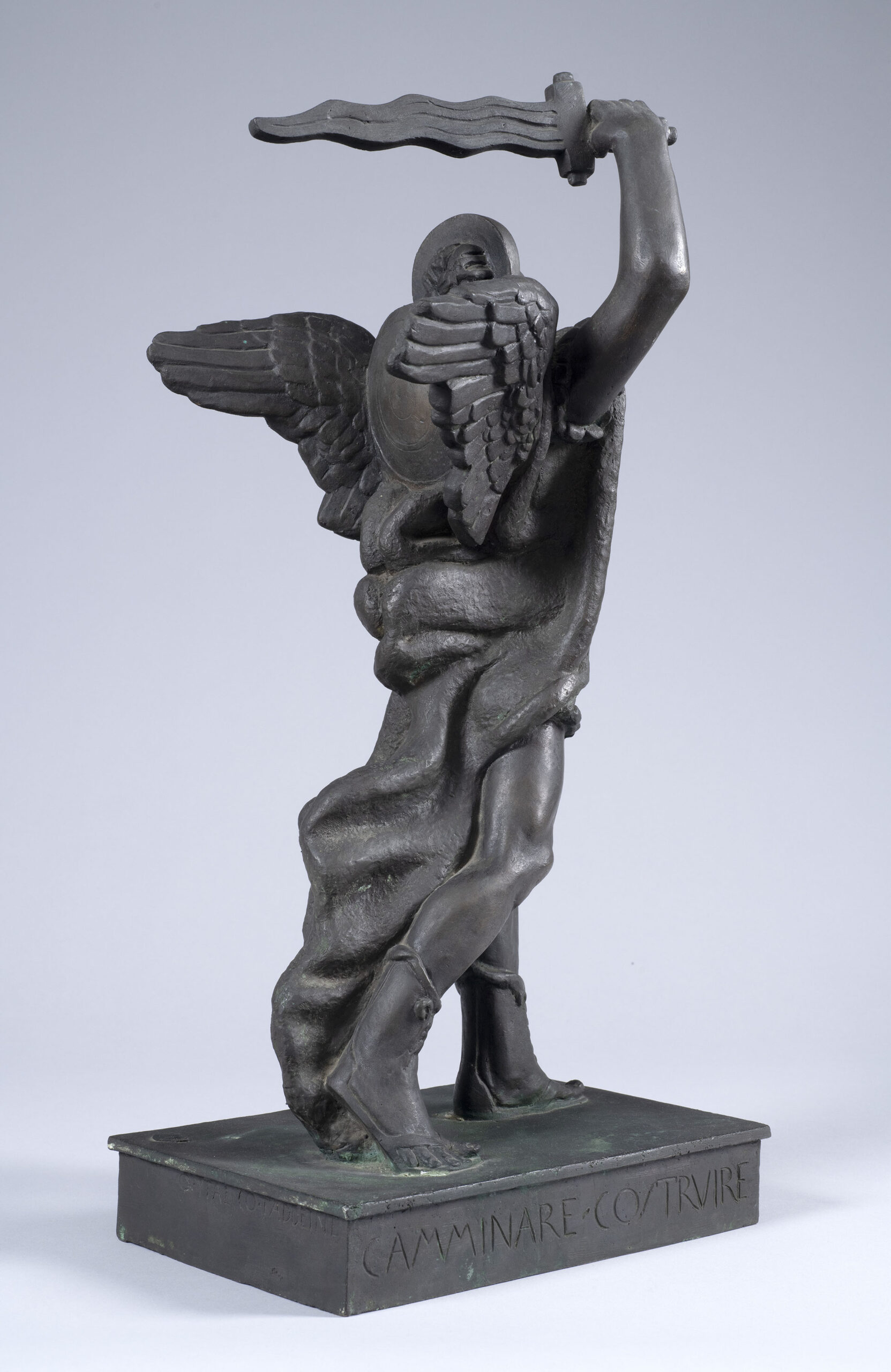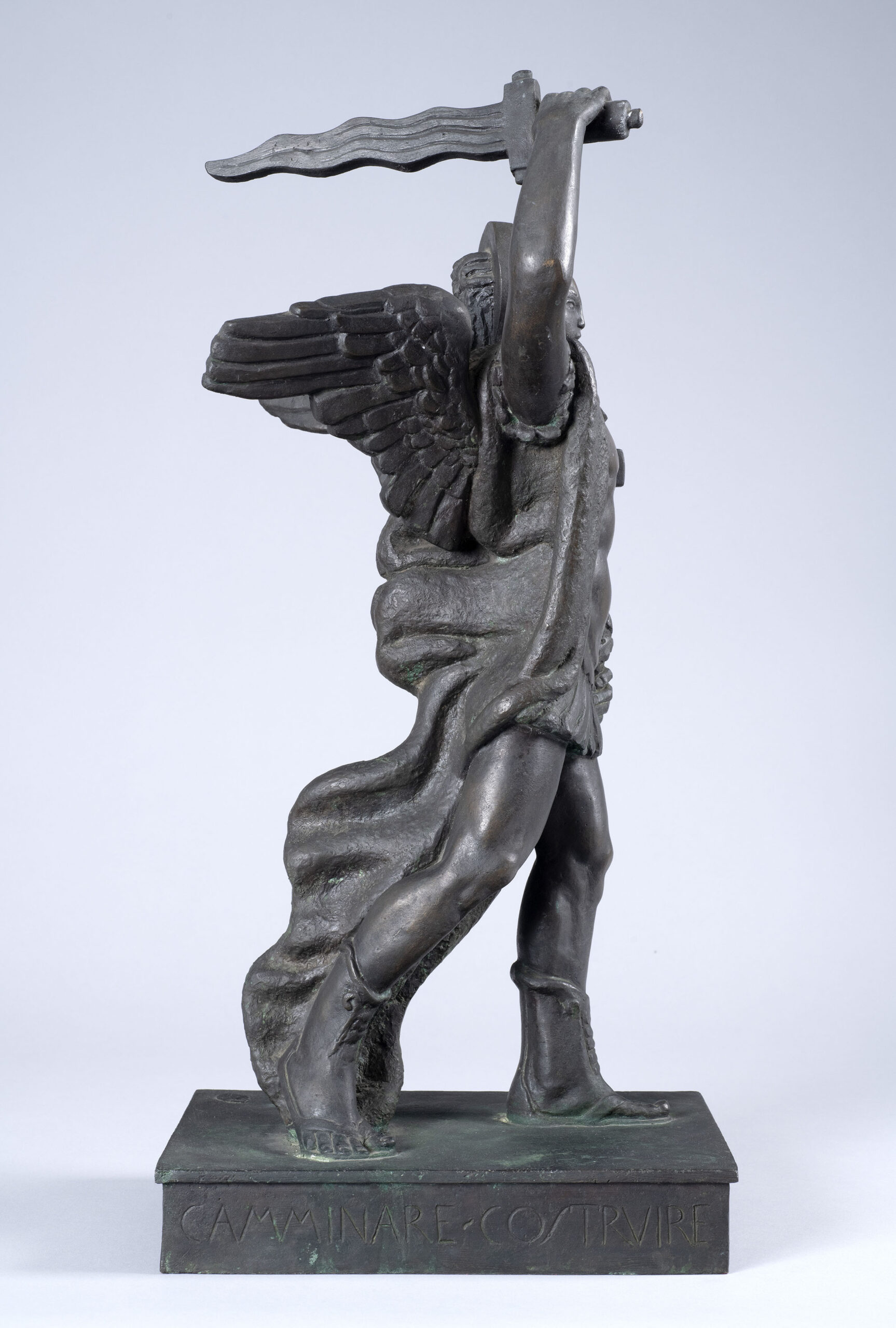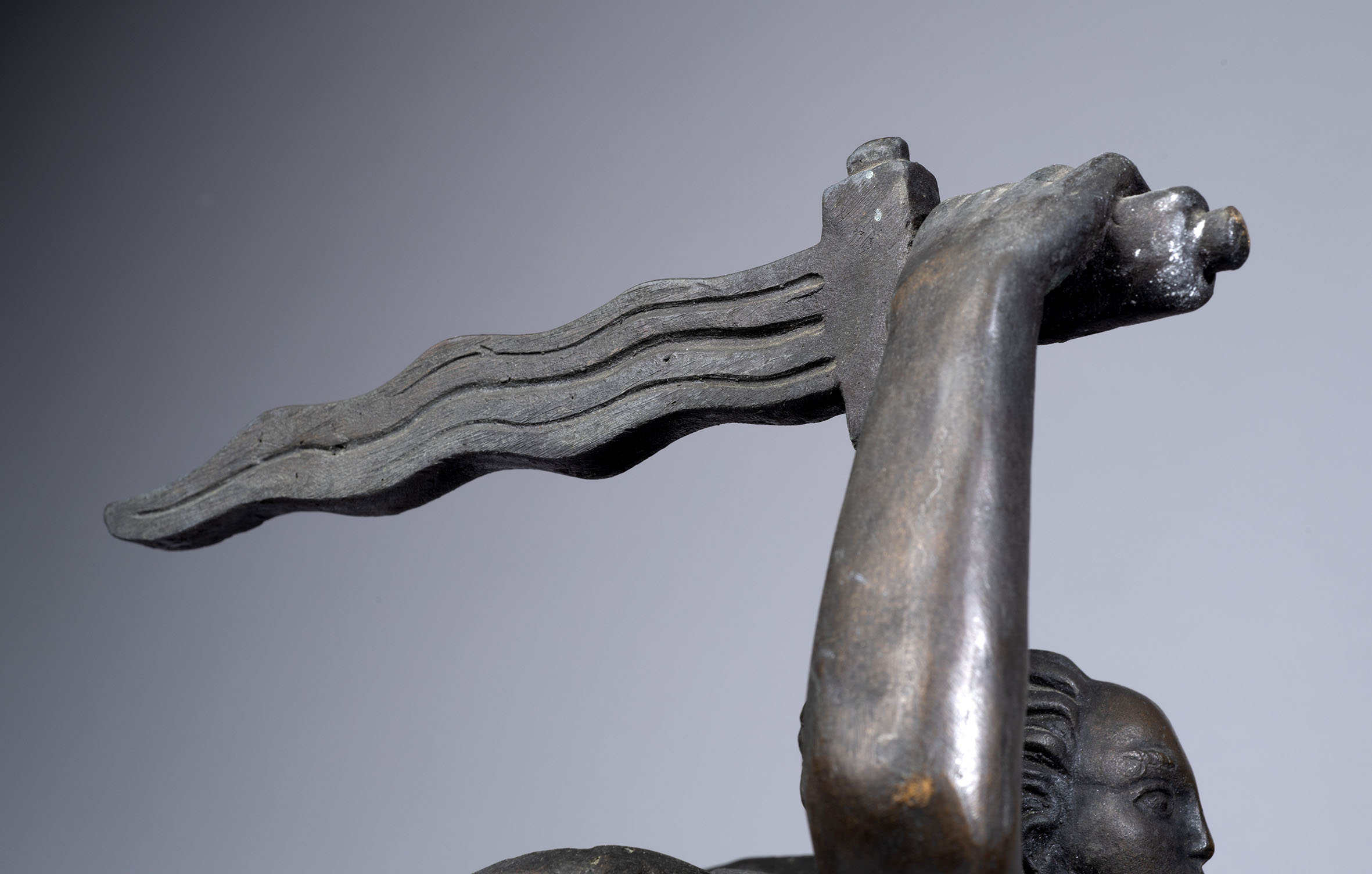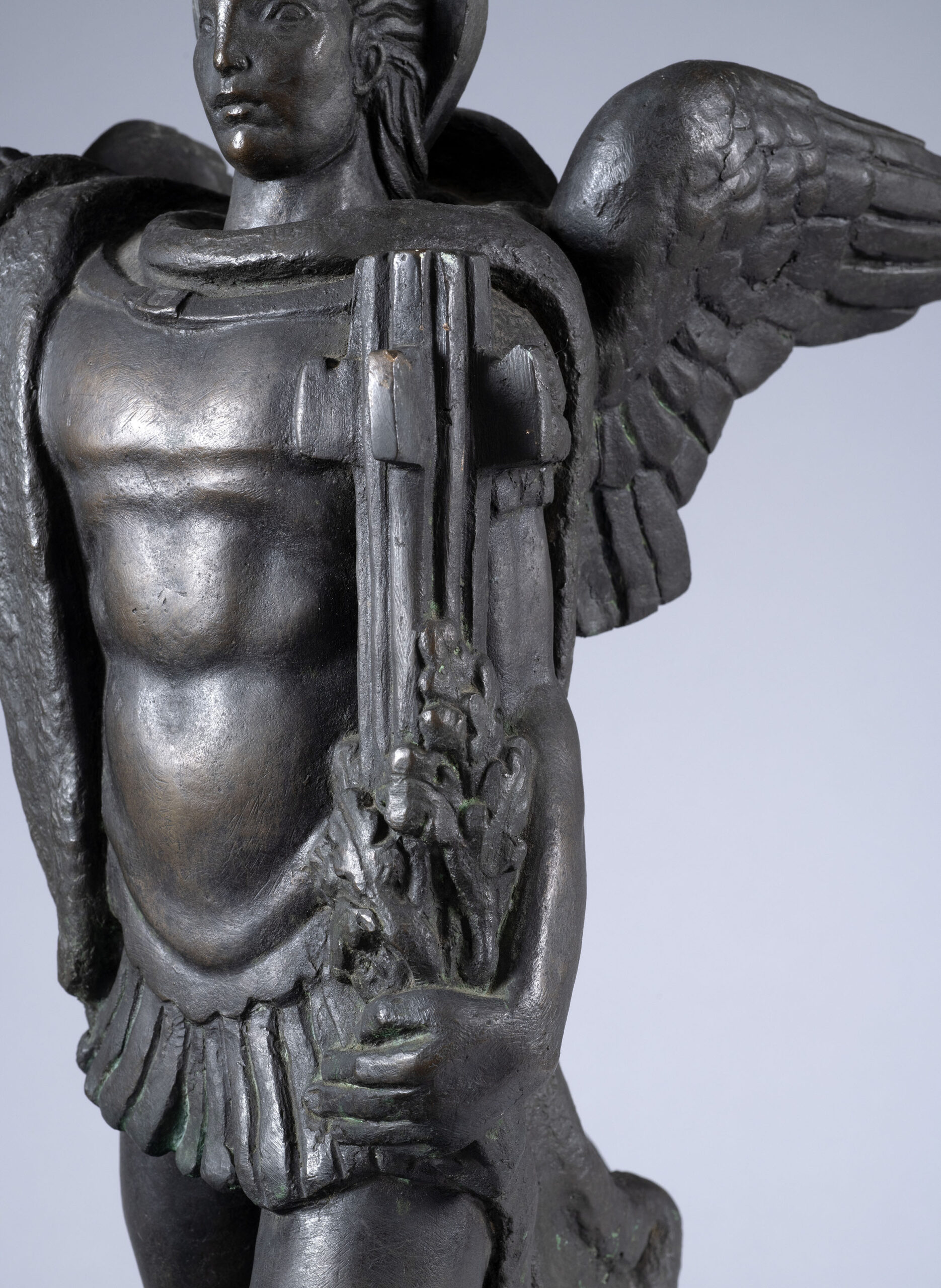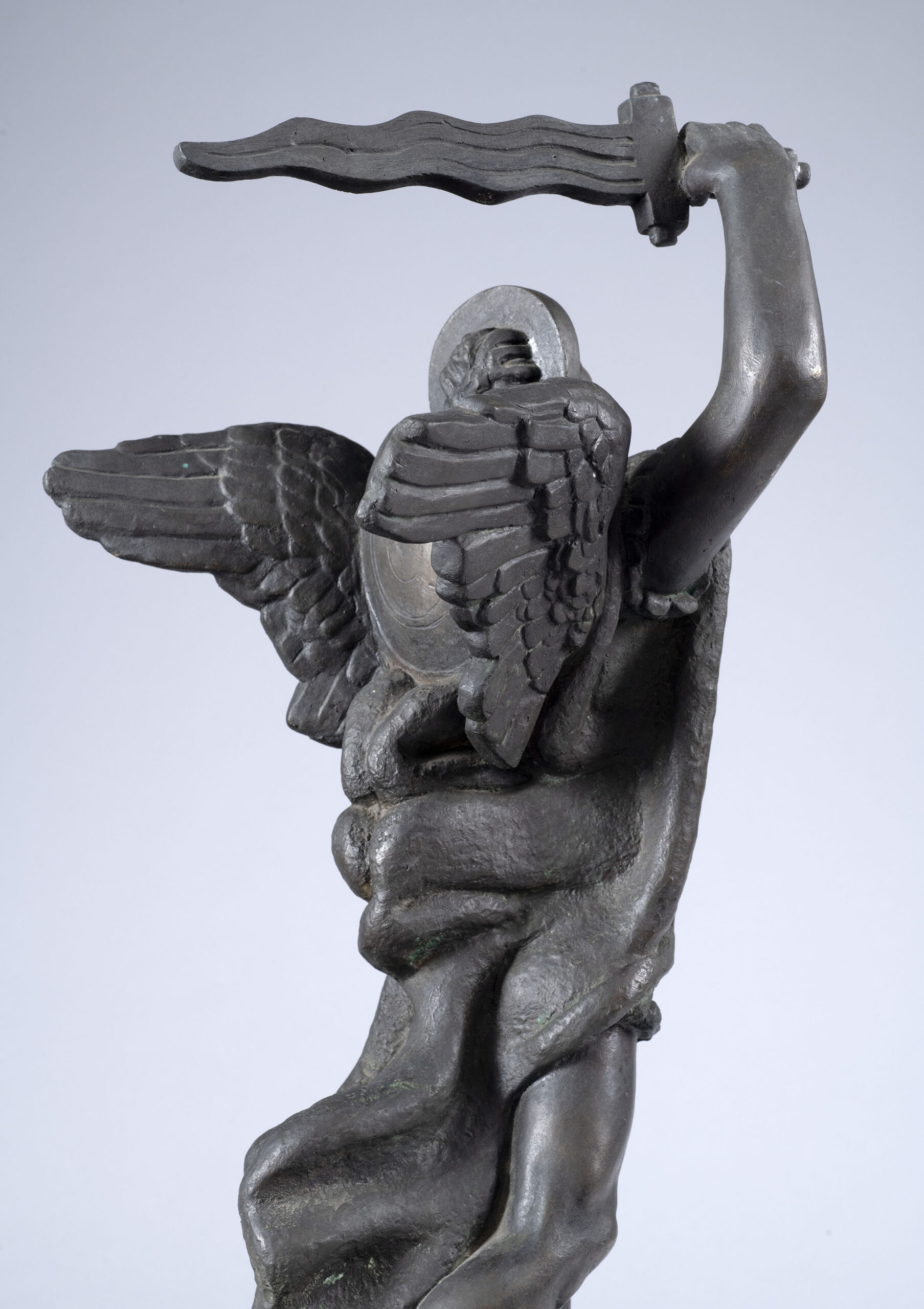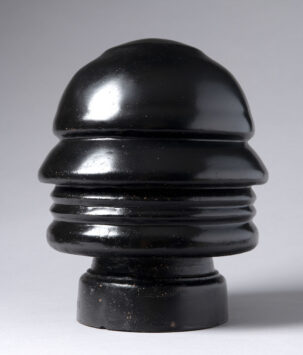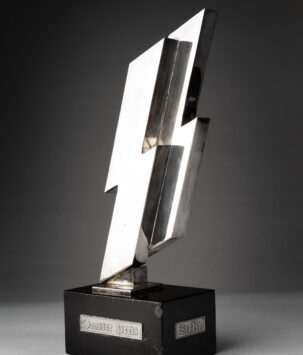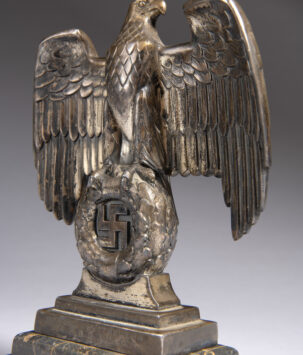Archangel Michael
Bronze sculpture by Omero Taddeini portraying Archangel Michael in his role as the guardian of the Fascist Blackshirts. Built in honor of the 10th anniversary of the March on Rome and having served as a preparatory model for a monumental sculpture intended for the Foro Mussolini (known today as the Foro Italico) in Rome, this sculpture is of considerable historical significance.
This bronze depiction of St. Michael embodies a powerful symbolism, blending biblical themes and elements of Italy’s ancient Roman heritage with ideological motifs drawn from Fascism. Archangel Michael is remembered as the commander of the heavenly armies who defeated Lucifer, and is often depicted winged, clad in armor and wielding a Flamberge, characterized by its unmistakable undulating blade. St. Michael was appointed guardian angel of Italy’s fascist revolutionaries in 1930 by members of the Milizia Volontaria per la Sicurezza Nazionale (MVSN), and was celebrated within their ranks with the following prayer:
“Principe della Milizia Celeste, Tu cacciasti dal cielo negli abissi infernali gli spiriti a Dio ribelli.
Militi d’Italia, noi Ti ammiriamo fedele, forte esecutore degli ordini dell’Onnipotente e siamo fieri di salutarti nostro modello e patrono.
Tu mantieni fedele l’animo nostro a Dio e alla Milizia Fascista, forte il nostro braccio contro i nemici della Patria, contro i ribelli alle sue leggi e all’ordine che il Duce vuole nella Nazione.
San Michele vincitore di Satana, proteggi noi, che vogliamo essere Soldati di Cristo, Militi del Duce, vincitori sempre in tutte le battaglie per la sicurezza e grandezza della Patria di quaggiù e per la conquista della gloria nella Patria celeste.
Amen.”
English translation:
“Prince of the Celestial Militia, You cast out of heaven into the infernal abysses the spirits rebellious to God.
Soldiers of Italy, we admire you as a faithful, strong executor of the orders of the Almighty and we are proud to hail you as our model and patron.
You keep our soul faithful to God and to the Fascist Militia, our arm strong against the enemies of the Fatherland, against those who rebel against its laws and against the order that the Duce wants in the Nation.
Saint Michael, conqueror of Satan, protect us, who want to be Soldiers of Christ, Soldiers of the Duce, always victorious in all battles for the safety and greatness of the Fatherland here below and for the conquest of glory in the heavenly Fatherland.
Amen. ”
The armor, shield and gladius represent the strength and enduring legacy of Rome, while the fasces held in the figure’s left arm serves as a tribute to the guiding ideology of Fascism. The statue’s dynamic pose, poised to strike with his flame-bladed gladius, conveys a sense of movement and authority, characteristic of the monumental futurist art commissioned during this period.
The meticulous attention to anatomical details and the dramatic composition demonstrates Taddeini’s mastery as a sculptor, making this piece an impressive example of early 20th-century Italian art. Its historical context and symbolic weight highlight its dual role as both a work of artistic excellence and an exemplar cultural product of Fascist Italy.
The Foro Mussolini, where this statue was originally intended for, is a large sports complex at the base of the Monte Mario and was renamed the Foro Italico after the war.
Across the four sides of the sculpture’s base are found the following inscriptions:
IL DECENNALE (The Decennary)
CAMMINARE – COSTRUIRE (Advance – Create)
COMBATTERE – VINCERE (Fight – Win)
O.ITALICO TADDEINI (Artist signature)
Free shipping on orders over $50!
- Satisfaction Guaranteed
- No Hassle Refunds
- Secure Payments
Bronze sculpture by Omero Taddeini portraying Archangel Michael in his role as the guardian of the Fascist Blackshirts. Built in honor of the 10th anniversary of the March on Rome and having served as a preparatory model for a monumental sculpture intended for the Foro Mussolini (known today as the Foro Italico) in Rome, this sculpture is of considerable historical significance.
This bronze depiction of St. Michael embodies a powerful symbolism, blending biblical themes and elements of Italy’s ancient Roman heritage with ideological motifs drawn from Fascism. Archangel Michael is remembered as the commander of the heavenly armies who defeated Lucifer, and is often depicted winged, clad in armor and wielding a Flamberge, characterized by its unmistakable undulating blade. St. Michael was appointed guardian angel of Italy’s fascist revolutionaries in 1930 by members of the Milizia Volontaria per la Sicurezza Nazionale (MVSN), and was celebrated within their ranks with the following prayer:
“Principe della Milizia Celeste, Tu cacciasti dal cielo negli abissi infernali gli spiriti a Dio ribelli.
Militi d’Italia, noi Ti ammiriamo fedele, forte esecutore degli ordini dell’Onnipotente e siamo fieri di salutarti nostro modello e patrono.
Tu mantieni fedele l’animo nostro a Dio e alla Milizia Fascista, forte il nostro braccio contro i nemici della Patria, contro i ribelli alle sue leggi e all’ordine che il Duce vuole nella Nazione.
San Michele vincitore di Satana, proteggi noi, che vogliamo essere Soldati di Cristo, Militi del Duce, vincitori sempre in tutte le battaglie per la sicurezza e grandezza della Patria di quaggiù e per la conquista della gloria nella Patria celeste.
Amen.”
English translation:
“Prince of the Celestial Militia, You cast out of heaven into the infernal abysses the spirits rebellious to God.
Soldiers of Italy, we admire you as a faithful, strong executor of the orders of the Almighty and we are proud to hail you as our model and patron.
You keep our soul faithful to God and to the Fascist Militia, our arm strong against the enemies of the Fatherland, against those who rebel against its laws and against the order that the Duce wants in the Nation.
Saint Michael, conqueror of Satan, protect us, who want to be Soldiers of Christ, Soldiers of the Duce, always victorious in all battles for the safety and greatness of the Fatherland here below and for the conquest of glory in the heavenly Fatherland.
Amen. ”
The armor, shield and gladius represent the strength and enduring legacy of Rome, while the fasces held in the figure’s left arm serves as a tribute to the guiding ideology of Fascism. The statue’s dynamic pose, poised to strike with his flame-bladed gladius, conveys a sense of movement and authority, characteristic of the monumental futurist art commissioned during this period.
The meticulous attention to anatomical details and the dramatic composition demonstrates Taddeini’s mastery as a sculptor, making this piece an impressive example of early 20th-century Italian art. Its historical context and symbolic weight highlight its dual role as both a work of artistic excellence and an exemplar cultural product of Fascist Italy.
The Foro Mussolini, where this statue was originally intended for, is a large sports complex at the base of the Monte Mario and was renamed the Foro Italico after the war.
Across the four sides of the sculpture’s base are found the following inscriptions:
IL DECENNALE (The Decennary)
CAMMINARE – COSTRUIRE (Advance – Create)
COMBATTERE – VINCERE (Fight – Win)
O.ITALICO TADDEINI (Artist signature)
